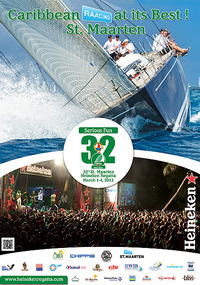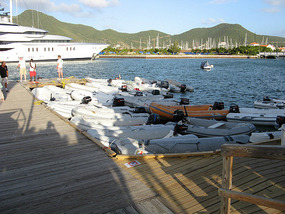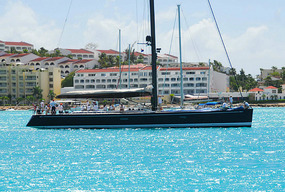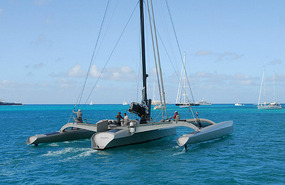Last season, after our participation in the 2011 Around St. Maarten Multihull Regatta, we observed some of the preparations for the 2011 St. Maarten Heineken Regatta one week later, but did not consider entering as our cruising itinerary took us away from St. Maarten before the regatta started and we weren't keen on all the crowds that this internationally renowned event attracted. But after our decent performance in the 2011 Around St. Maarten Multihull Regatta, and after deciding to come back to the eastern Caribbean for this season, planning to enter both the 2012 Around St. Maarten Multihull Regatta and the 32nd St. Maarten Heineken Regatta – still scheduled a week apart - was an easy decision. Capt. Wally (crew for the 2011 race) had agreed to join us for both races and we knew Bob, Beckie, Paul and Linda all desired to visit in that timeframe so the pieces started to fit together. After fine tuning all the arrival and departure dates of our guests, we had in place the willing crew for each race that we needed to pull it all off – while still allowing some vacation time for our guests. So enter both regattas we did. We added crewmember Mike from Awakening as he was available after the Around St. Maarten Multihull Regatta.
This year’s event would be the 32nd St. Maarten Heineken Regatta and it has garnered quite a favorable reputation over the years. If you’re an active racer, you’ve at least heard of it or perhaps dreamed of being part of it. As described in Caribbean sailing publication, All at Sea, "No other Caribbean regatta brings together such a gathering of international, regional, and local sailing talent…." Reading this year’s entry list is like reading the Who’s Who of yachting as the celebrated rock stars of the sport return year after year.
Bottom line, in yacht racing, this is the BIG TIME!
The regatta is a six-day yacht racing festival, consisting of three separate races in the main event, this year being held on March 2, 3, and 4. Prior to that, two “regattas within a regatta” were held for specialty races on February 28 and March 1. In between the action on the water, the whole island of St. Martin – both the French and Dutch side – is consumed by shore activities designed to bring non-sailors to the event, highlighted by huge parties and music performances each evening after the three main races with the final night’s party doubling as the huge regatta awards ceremony.
Over 200 boats were entered in this year’s regatta for the three-race main event. The entrants were subdivided into 16 separate classes to group similar boats to compete against each other. The 16 classes were each grouped into two sub-divisions and assigned to one of two “starting circles”, A or B. This permitted two simultaneously run starting lines for each race – located a mile or two apart – in order to get all 200+ boats in the 16 classes started in half the time – each class getting its own start.
The Starting Circles consisted of a committee boat and a nearby inflatable buoy set perpendicular to the wind to provide a standard yacht racing starting line. A windward mark was set approximately 1 mile upwind from the start which became the first mark of every race, providing an upwind leg after the start, also standard yacht racing procedure. The race courses were set all around the island and consisted of approximately twenty temporary turning marks as well as natural features, such as small islands. Once started, the 16 different classes would use many of the same turning marks, depending on their assigned courses. For each class in each of the three races, the Race Committee would announce (on each morning of each race just prior to start) a course to sail consisting of some combination of marks to go around. There was a common finish line for all classes.
Included in the racing instructions we would receive were the GPS coordinates for each temporary turning mark which wasn’t an obvious natural feature. Thus, we knew the GPS coordinates for all the small, inflatable buoys used as turning marks – which are hard to see from a distance. Back on the boat, Navigator Donna loaded all the locations of all the marks we might have to find into our chart plotter as waypoints to be easily seen on our electronic chart of the island. No guessing where that next mark should be for us! This would also assist us in calling our tacks on the upwind legs.
In the big picture, the three races started and finished in the same general area for all classes:
Race 1 on Friday, March 2, was the “around the island” race which started off Simpson Bay, went clockwise around the island, and finished off Philipsburg. Individual classes may have been assigned additional intermediate marks to round. The post race evening festivities were held on the waterfront in the Philipsburg finish venue. Boats could either anchor in the harbor at Philipsburg for the night or return to nearby Simpson Bay or Simpson Bay Lagoon.
Race 2 on Saturday, March 3, was from Philipsburg to Marigot Bay on the French side. Again, individual classes may have been assigned additional intermediate or extra marks to round. Post race evening festivities were held on the waterfront in the Marigot finish venue. Almost all the boats anchored in Marigot Bay for the night or tied up at the marina there.
Race 3 on Sunday, March 4, was from Marigot Bay back to Simpson Bay on the Dutch side. Once again, individual classes may have been assigned additional, intermediate or extra marks to round. Post race evening festivities, including the final awards ceremony, were held on Kim Sha Beach on Simpson Bay.
The corrected time finish position in each race for each boat in a class became their “score” for the race, e.g., first place in class gets 1 point; second place in class gets 2 points, etc. Low combined score for the three races wins the regatta in that class division.
A preliminary entry form for Pas de Deux had been completed online back in early February when we found some internet access in time to meet the February 23 entry deadline. Race Headquarters was at St. Maarten Yacht Club not too far from our anchorage in Simpson Bay. On March 1 we all went to the yacht club to finalize our entry and get all the race details we needed. At this time we learned we had been assigned, appropriately, to the Multihull 2 class which included eleven other cruising type multihulls (catamarans and trimarans). Further, we were assigned Start Circle B with nine classes total and would sail the B courses, of which there were several possible for each race. The Race Committee’s choice could depend on that day’s sailing conditions and, as mentioned, would not be communicated to entrants until just prior to each race start. Multihull 1 class, assigned to Start Circle A and the A courses, consisted of multihull vessels more explicitly designed for racing, i.e., stripped out, go-fast machines. There were just five boats in Multihull 1.
The remaining 14 classes were all monohulls of varying sizes and sophistication: from heavy, live aboard cruising boats to the most tricked out pure racing machines afloat with their professional crews. Included were six classes of bareboat charter boats. (Yes, sailing friends, you can charter a Moorings, Sunsail or one of several other charter company boats and enter the Heineken Regatta.) The other classes assigned to the B Start and B courses with us were all six bareboat classes, one monohull non-bareboat class (CSA7), and the Lottery class consisting of more laid back cruising monohulls who just wanted to participate for fun and to go to the parties….
Dave was somewhat disappointed to learn that on Start Circle B our Multihull 2 class was specified to start after all other B classes, except for the Lottery class (presumably the slowest) which was to start last. For each race, the B start schedule commenced at 10:00 AM each day with Bareboat 1 class, followed by the other five bareboat classes and the one non-bareboat monohull class, CSA7, each class starting ten minutes apart. This meant our start wasn’t until 11:10 and we could spend the entire race picking our way around likely slower boats. Typically, regattas that start with multiple classes on the same starting line and courses would schedule the fastest boats to start first to reduce congestion on the course. Apparently the Race Committee felt the speed of the multihulls in Multihull 2 would not outdo the speed of the bareboats scheduled to precede them. In Dave’s mind, “Oh well, it will be kinda’ fun to pass all the slower boats….” But this would give Tactician Wally a full time job to keep us out of trouble in port-starboard situations.
We were thankful we didn’t have to compete with the Multihull 1 fleet of racers which included Coco de Mer-- a Gunboat 66-- and Paradox-- an exotic 63-foot trimaran that looked more like a Klingon war bird. In addition to the Multihull 1 class, the A classes included other flat-out monohull racing machines like Le Penquin, the winner of the Velux 5 Oceans single handed around the world race, skippered by Brad Van Liew; and skippers like Bouwe Bekking, five times around the world veteran sailing Antelope, a 46-foot Grand Soleil. There were also big expensive boats that are as impressive racing as they are sitting at the dock, like the magnificent Swan 100, Virago, and its “little” sister, the Swan 90, Nefertiti. Because we were starting later on Start Circle B, we didn’t see much of these boats, except during Race 3. As you could expect, most boats entered in the A classes sail with professional crews. But even the bareboats registered in the B classes are typically entered by racing aficionados with plenty of racing experience.
At this early stage of our participation we could tell this was a well planned event requiring hundreds of people to organize and run. The registration process was smooth and efficient. A dozen or so LED screens displayed registration information for each racing class. These same screens would later show individual race results, set up both at race headquarters and at each race finish venue. The “goodie bag” received by each entry was a shoulder bag with about 25 pounds of stuff, including various trinkets, several hats, a bottle of Captain Morgan, and a six pack of Heineken. Cheap Heineken beer flowed continuously throughout the week. The oft repeated slogan of the regatta is “Serious Fun.” Indeed….
As part of the thorough planning, a free water taxi system was established to ferry racing crews between anchored boats and shore. Because most boats entered don’t carry dinghies, water taxis roam the anchorages and can be summoned by hoisting a “water taxi” flag (provided in the “goodie bag”) to pick up crew for shuttle to shore and vice versa. After dark? Not to worry--just twirl the light stick also provided in the goodie bag. On shore and need to get back to a boat? Just present the credit card sized plastic water taxi pass provided at registration for each crew member. Because we had our dinghy securely tied up in “offshore mode” on Pas de Deux’s davits where it always hangs (we would race with the dinghy aboard in true cruiser fashion!), we took advantage of the water taxi system. We never had to wait more than a few minutes for the volunteers who make this great service work.
At registration there was ample weather information posted confirming what we had been monitoring for the several days preceding—it was going to be windy as hell, with correspondingly rough seas. Typical late winter trade winds from the ENE to E at 18-23 knots were forecast for Race 1, increasing slightly the next two days for Races 2 and 3. Seas were forecast to be consistent with the wind forecast – 6 to 8 feet and building over the period.
The same person who managed the multihull rating process for the Around St. Maarten Multihull Regatta the week before did so for the Heineken Regatta as well. So our rating information transferred directly and we received the identical rating of 0.948. Compared to the rest of the Multihull 2 entries, we were rated the fourth fastest boat, i.e., three boats were theoretically faster than us. These included two other Catanas, another 471 and a new design 47, both declaring more sails, and a 50-foot Erek Lerouge design. Three in our class had sailed in the Around St. Maarten Multihull Regatta, including local favorites Guimamalou (another Erik Lerouge design), and Katzenellenbogen, a Lagoon 410, oddly renamed Team Organizational Restructuring on the entry form, and skippered by Sir Robbie Ferron, originator/founder of the Heineken Regatta 32 years ago who only a few weeks prior had resigned his long-standing position as Chairman of the Regatta Steering Committee. “Sir Robbie” as he is well known locally is also the founder of the Budget Marine chandleries now located throughout the Caribbean. Also returning to the Multihull 2 class was the Russian crew of last year’s winner, Nikiforov, a Lagoon 500, now sailing a Lagoon 450, Nala. Some serious, talented competition indeed….
An excerpt from pre-race press: “The multihull class of seventeen boats is by far the most successful multihull class in the Caribbean…. The fast machines will see regular winner Soma (from St John USVI) up against boats like Paradox, the 63 ft Irens trimaran and the Gunboat Coco de Mer entered by Katherine Mullins…. Around 11 cruising catamarans will sail with entries from Ukraine and Russia who will compete with local jaw breakers Guimamalou and Katzenellenbogen.”
Pas de Deux was clearly not even on the radar screen….
Follow the race by reading our next blog entry, "Let the Racing Begin!"
Preps for the 32nd St. Maarten Heineken Regatta
Thursday, March 01, 2012
 Simpson Bay, Saint Martin
Simpson Bay, Saint Martin
Other Entries
-
181Our Return to the Spanish Virgin Islands
Dec 1478 days prior Culebra, Puerto Ricophoto_camera26videocam 1comment 0
Culebra, Puerto Ricophoto_camera26videocam 1comment 0 -
182Eastward Bound
Dec 1874 days prior Charlotte Amalie, Virgin Islands USphoto_camera1videocam 0comment 0
Charlotte Amalie, Virgin Islands USphoto_camera1videocam 0comment 0 -
183Seeking New Destinations in the BVI
Dec 1973 days prior Soper's Hole, Virgin Islands USphoto_camera0videocam 0comment 0
Soper's Hole, Virgin Islands USphoto_camera0videocam 0comment 0 -
184Exploring the Islands of Sir Francis Drake Channel
Dec 2666 days prior Buck Island, Virgin Islands Britishphoto_camera15videocam 0comment 0
Buck Island, Virgin Islands Britishphoto_camera15videocam 0comment 0 -
185Exploring Virgin Gorda's North Sound
Jan 0754 days prior Robin Bay, Virgin Islands Britishphoto_camera54videocam 7comment 0
Robin Bay, Virgin Islands Britishphoto_camera54videocam 7comment 0 -
186Moving Back Westward Through the BVI
Jan 1051 days prior Valley Trunk Bay, Virgin Islands Britishphoto_camera11videocam 0comment 0
Valley Trunk Bay, Virgin Islands Britishphoto_camera11videocam 0comment 0 -
187Destination Little Jost Van Dyke
Jan 1150 days prior Sandy Spit, Virgin Islands Britishphoto_camera7videocam 0comment 0
Sandy Spit, Virgin Islands Britishphoto_camera7videocam 0comment 0 -
188Great Expectations, Great Escapes
Jan 1249 days prior Cane Garden Bay, Virgin Islands Britishphoto_camera1videocam 0comment 0
Cane Garden Bay, Virgin Islands Britishphoto_camera1videocam 0comment 0 -
189Final Winter Days in the British Virgin Islands
Jan 1546 days prior Cane Garden Bay, Virgin Islands Britishphoto_camera5videocam 0comment 0
Cane Garden Bay, Virgin Islands Britishphoto_camera5videocam 0comment 0 -
190A Day in the Life
Jan 1645 days prior Cruz Bay, Virgin Islands USphoto_camera0videocam 0comment 0
Cruz Bay, Virgin Islands USphoto_camera0videocam 0comment 0 -
191Short Visits with Friends Arriving in the Islands
Jan 2437 days prior Crown Bay, Virgin Islands USphoto_camera15videocam 0comment 0
Crown Bay, Virgin Islands USphoto_camera15videocam 0comment 0 -
192Aiming for a Vacation to Remember
Feb 0327 days prior Crown Bay, Virgin Islands USphoto_camera68videocam 6comment 0
Crown Bay, Virgin Islands USphoto_camera68videocam 6comment 0 -
193Rendezvous with S/V Southern Cross
Feb 0525 days prior Brewers Bay, Virgin Islands USphoto_camera1videocam 0comment 0
Brewers Bay, Virgin Islands USphoto_camera1videocam 0comment 0 -
194Friends and Anemones
Feb 0723 days prior Round Bay, Virgin Islands USphoto_camera39videocam 4comment 0
Round Bay, Virgin Islands USphoto_camera39videocam 4comment 0 -
195Destination Sint Maarten
Feb 1317 days prior Simpson Bay, Saint Martinphoto_camera4videocam 0comment 0
Simpson Bay, Saint Martinphoto_camera4videocam 0comment 0 -
196Travel to the Enchanting Island of Saba
Feb 1911 days prior Saba, Netherlands Antillesphoto_camera17videocam 1comment 0
Saba, Netherlands Antillesphoto_camera17videocam 1comment 0 -
197Around St. Maarten Multihull Regatta
Feb 228 days prior Simpson Bay, Saint Martinphoto_camera12videocam 1comment 0
Simpson Bay, Saint Martinphoto_camera12videocam 1comment 0 -
198Preps for the 32nd St. Maarten Heineken Regatta
Mar 01 Simpson Bay, Saint Martinphoto_camera5videocam 0comment 0
Simpson Bay, Saint Martinphoto_camera5videocam 0comment 0 -
199Let the Racing Begin!
Mar 021 day later Simpson Bay, Saint Martinphoto_camera22videocam 0comment 0
Simpson Bay, Saint Martinphoto_camera22videocam 0comment 0 -
200The Pink Sands of Barbuda with Paul and Linda
Mar 076 days later Gravenor Bay, Antigua and Barbudaphoto_camera41videocam 0comment 0
Gravenor Bay, Antigua and Barbudaphoto_camera41videocam 0comment 0 -
201Paul and Linda’s Vacation Continues
Mar 1312 days later Codrington, Antigua and Barbudaphoto_camera25videocam 0comment 0
Codrington, Antigua and Barbudaphoto_camera25videocam 0comment 0 -
202Return to the US Virgin Islands
Mar 1817 days later Marigot Bay, Saint Martinphoto_camera1videocam 0comment 0
Marigot Bay, Saint Martinphoto_camera1videocam 0comment 0 -
203Brother Pete’s 1st Visit to Virgin Islands
Apr 0232 days later St. Thomas, Virgin Islands USphoto_camera13videocam 0comment 0
St. Thomas, Virgin Islands USphoto_camera13videocam 0comment 0 -
204Together Again – Lingering in the USVI
Apr 1242 days later Buck Island, Virgin Islands USphoto_camera10videocam 0comment 0
Buck Island, Virgin Islands USphoto_camera10videocam 0comment 0 -
205Choosing the More Direct Route Homeward
Aug 28180 days later Norfolk, United Statesphoto_camera17videocam 1comment 0
Norfolk, United Statesphoto_camera17videocam 1comment 0 -
206Summer Maintenance and Re-launch of Pas de Deux
Nov 08252 days later Drayden, United Statesphoto_camera22videocam 0comment 0
Drayden, United Statesphoto_camera22videocam 0comment 0 -
207Passage from the Chesapeake to the Bahamas
Nov 09253 days later Little Creek, United Statesphoto_camera17videocam 0comment 0
Little Creek, United Statesphoto_camera17videocam 0comment 0 -
208Enjoying the first days with our crew
Nov 14258 days later Spanish Wells, Bahamasphoto_camera29videocam 0comment 0
Spanish Wells, Bahamasphoto_camera29videocam 0comment 0 -
209On our own again...naturally! Cruising Eleuthera
Nov 16260 days later Eleuthera, Bahamasphoto_camera27videocam 0comment 0
Eleuthera, Bahamasphoto_camera27videocam 0comment 0 -
210A Visit to Little San Salvador, Bahamas
Nov 28272 days later Little San Salvador Island (Half Moon Cay), Bahamasphoto_camera2videocam 0comment 0
Little San Salvador Island (Half Moon Cay), Bahamasphoto_camera2videocam 0comment 0 -
211Cruising Cat Island, Bahamas
Dec 03277 days later Cat Island, Bahamasphoto_camera73videocam 7comment 0
Cat Island, Bahamasphoto_camera73videocam 7comment 0 -
212Cruising Long Island, Bahamas
Dec 15289 days later Long Island, Bahamasphoto_camera33videocam 0comment 0
Long Island, Bahamasphoto_camera33videocam 0comment 0 -
213Destination Crooked and Acklins Islands, Bahamas
Dec 28302 days later Acklins Island, Bahamasphoto_camera110videocam 5comment 0
Acklins Island, Bahamasphoto_camera110videocam 5comment 0 -
214Cruising Samana Cay, Bahamas
Feb 06342 days later Samana Cay, Bahamasphoto_camera23videocam 1comment 0
Samana Cay, Bahamasphoto_camera23videocam 1comment 0 -
215Cruising San Salvador, Bahamas
Feb 12348 days later San Salvador, Bahamasphoto_camera29videocam 2comment 0
San Salvador, Bahamasphoto_camera29videocam 2comment 0 -
216On to Conception Island, Bahamas....
Feb 18354 days later Conception Island, Bahamasphoto_camera28videocam 0comment 0
Conception Island, Bahamasphoto_camera28videocam 0comment 0

 Simpson Bay, Saint Martin
Simpson Bay, Saint Martin












2025-05-23